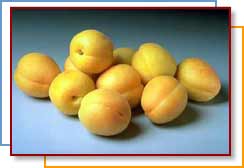
|
|
Apricot |
Serving
size 1/2 cup, sliced (83g)
| Amounts
Per Serving |
% Daily
Value |
| Calories
40 |
|
| Calories
from Fat 5 |
|
| Total Fat
0g |
0% |
| Saturated
Fat 0g |
0% |
| Cholesterol
0mg |
0% |
| Sodium 0mg |
0% |
| Total
Carbohydrate 9g |
3% |
|
Dietary Fiber 1g |
4% |
|
Sugars 11g |
|
| Protein 1g |
|
| Vitamin A |
30% |
| Vitamin C |
15% |
| Calcium |
2% |
| Iron |
2% |
* Percent Daily Values are based on a
2,000 calorie diet. |
|
| |
|
In Latin, apricot means "precious," a label earned because it ripens
earlier than other summer fruits. A relative of the peach, the apricot is
smaller and has a smooth, oval pit that falls out easily when the fruit is
halved.
Apricots originally came from China. This golden fruit has been around for
more than 4,000 years. Apricots progressively made their way through the
Persian Empire to the Mediterranean where they were fondly adopted.
Spanish explorers introduced the apricot to the New World, and they were
planted in the gardens of Spanish missions all over California. The first
recorded major production of apricots in America was in 1792 south of San
Francisco.
In the United States, 95% of apricots grow in the San Joaquin Valley
and other parts of northern California. More than 400 growers produce many
varieties of apricots, the most common of which are featured in the table
below. Growers continually experiment with new varieties that deliver
sweet flavor and ship or process well.
|
|
Apricot variety |
Average maturity
date |
General size
|
Profile/
Flavor |
|
Pattersons |
June 15 |
Medium |
Firm/Good Flavor |
| Blenheims |
June 19 |
Medium |
Firm/Good Flavor |
| Tiltons |
June 25 |
Large |
Firm/Tart Flavor |
|
Castlebrites |
May 28 |
Medium |
Firm/Full Flavor |
| Source:
http://www.califapricot.com/* |
|
|
| |
|
Look for plump apricots with as much golden orange color as possible.
Stay clear of fruit that is pale yellow, greenish-yellow, very firm,
shriveled, or bruised. Apricots that are soft-ripe have the best flavor,
but they must be eaten immediately.
Apricots will ripen at room temperature. To help them ripen, place them in
a paper bag with an apple. When they yield to gentle pressure, they are
ready to eat. Refrigerate ripe apricots, unwashed, in a paper or plastic
bag up to 2 days. Wash them before eating. They are a perfect fast food
anytime. To cut fruit, slice around its seam, twist it in half, and lift
out the pit.
Apricots are available throughout the year from different regions:
- Mid-February through mid-March from Chile
- Mid-June through mid-July from California
- Mid-July through mid-August from Washington
|
|
What About Dried Apricots? |
| The
nutrients (e.g., beta-carotene and niacin) are more
concentrated in dried than in fresh apricots. Dried apricots
also have a higher sugar content, which makes them more likely
to stick on your teeth. Your dentist will remind you to brush
or rinse your teeth after eating any dried fruit or sticky
foods. If you’re allergic or sensitive to sulfites, remember
to look on the label of the package to see if the apricots
were treated with sulfur dioxide for color preservation. Look
in health-food stores for apricots that were not treated with
sulfites. They’ll be brown, not orange. |
|
| |
|
Apricots are great to eat raw, but they are also terrific cooked. These
are some common cooking methods:
Broiling or grilling: Try threading the apricots (whole or halved) on
skewers. Brush them with a little honey, and grill until semi-soft.
Broiling apricots is easy. Simply halve the apricots, place them on a
cookie sheet with the skin down and the cut side up, and heat for 7 to 10 minutes.
Poaching: It’s a great method for making a delicious sauce. Simply place
the apricots with their skins intact into simmering water or fruit juice,
and cook until tender. Adding spices such as cinnamon or cloves enhances
the apricot taste. When the apricots are tender, the poaching liquid can
be used as a sauce. Poaching takes about 6 to 8 minutes.

Recipes
 Savory
Fresh Apricot Bites Savory
Fresh Apricot Bites
Serves 12. Each serving equals 1/2 cup of fruit or vegetables
Source: California Fresh Apricot Council
Ingredients
4 oz fat-free cream cheese, softened
12 fresh apricots, halved
½ cup pistachios, finely chopped
Stir cream cheese until smooth; pipe or spoon into apricot halves.
Sprinkle tops with pistachios. Serve as an appetizer, snack, or dessert.
Nutritional analysis per serving: Calories 77, Protein 3g, Fat 3g,
Calories From Fat 26%, Carbohydrates 10g, Cholesterol 0mg, Fiber 2g,
Sodium 52mg.
Find more in our
recipe database!
|



